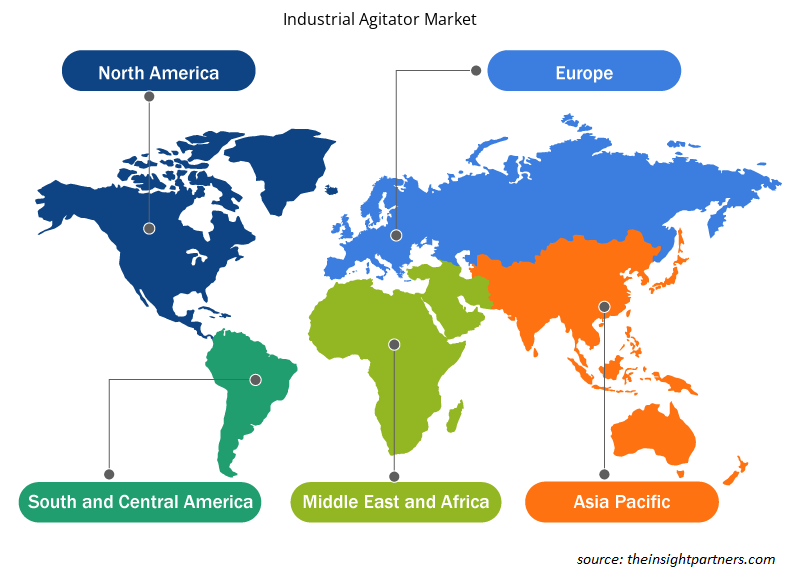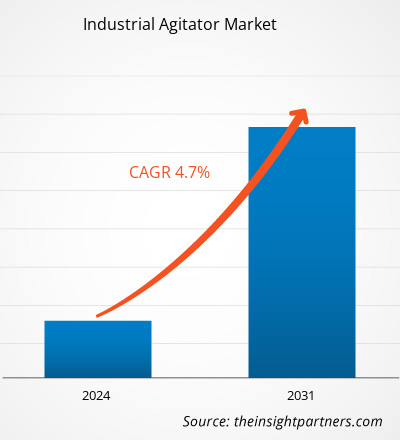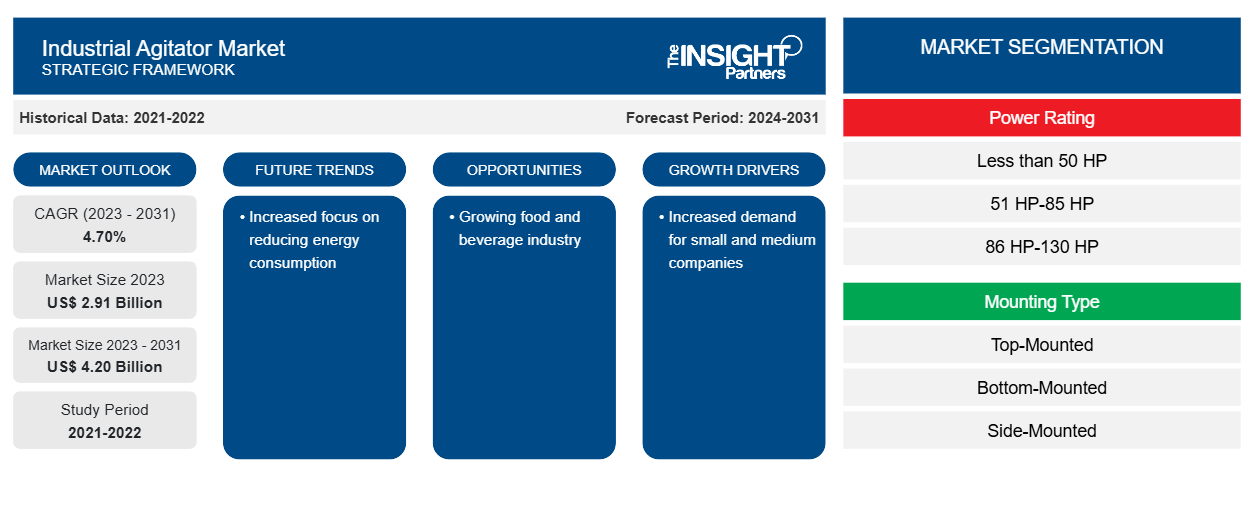Si prevede che la dimensione del mercato degli agitatori industriali raggiungerà i 4,20 miliardi di dollari entro il 2031, rispetto ai 2,91 miliardi di dollari del 2023. Si prevede che il mercato registrerà un CAGR del 4,70% nel 2023-2031. Molti produttori del settore si stanno concentrando sulla riduzione del consumo di energia. Pertanto, la domanda e l'adozione di componenti a risparmio energetico come azionamenti a velocità variabile e simulazione fluidodinamica computazionale, tra gli altri.
Analisi di mercato degli agitatori industriali
Aumento della domanda da parte dell'industria farmaceutica. Gli agitatori nell'industria farmaceutica vengono utilizzati per miscelare un'ampia gamma di liquidi e polveri insieme a un'ampia gamma di materiali. La crescita nell'industria farmaceutica aumenta direttamente la domanda di agitatori industriali. Ad esempio, secondo i dati pubblicati dalla Food and Drug Administration degli Stati Uniti nel 2023, le strutture biofarmaceutiche negli Stati Uniti nel 2018 erano 1018. Tuttavia, il numero ha raggiunto 1580 nel 2023. Inoltre, secondo i dati pubblicati dalla National Library of Medicine nel 2022, le spese farmaceutiche negli Stati Uniti sono aumentate di circa l'8% nel 2021, raggiungendo i 576,9 miliardi di dollari. Tale crescita nell'industria farmaceutica sta guidando il mercato.
Panoramica del mercato degli agitatori industriali
Molti produttori del settore si stanno concentrando sulla fornitura di agitatori personalizzati per i loro utenti finali. I requisiti di ogni utente finale sono diversi tra loro. Pertanto, i produttori stanno fornendo soluzioni personalizzate. Si prevede che la categoria di agitatori industriali montati in alto dominerà il mercato. Gli agitatori montati in alto assicurano una miscelazione omogenea , un'elevata affidabilità del processo e bassi costi operativi, tra gli altri. Inoltre, in termini di regione, si prevede che l'Asia Pacifica creerà opportunità redditizie per il mercato degli agitatori industriali grazie alla continua crescita del settore industriale.
Personalizza questo report in base alle tue esigenze
Riceverai la personalizzazione gratuita di qualsiasi report, comprese parti di questo report, o analisi a livello nazionale, pacchetto dati Excel, oltre a usufruire di grandi offerte e sconti per start-up e università
-
Scopri le principali tendenze di mercato in questo rapporto.Questo campione GRATUITO includerà analisi di dati che spaziano dalle tendenze di mercato alle stime e alle previsioni.
Driver e opportunità del mercato degli agitatori industriali
Aumento della domanda per le piccole e medie imprese
Il numero totale di piccole e medie imprese in tutto il mondo sta crescendo a livello globale. Secondo i dati pubblicati dal governo degli Stati Uniti nel 2023, ci sono circa 33 milioni di piccole imprese negli Stati Uniti, che rappresentano il 46% delle aziende del settore privato negli Stati Uniti. Ciò mostra un numero crescente di piccole imprese negli Stati Uniti. Un numero così crescente di piccole imprese sta guidando la necessità del mercato degli agitatori industriali.
Crescita dell'industria alimentare e delle bevande
La domanda per l'industria alimentare e delle bevande sta crescendo a causa dell'aumento della popolazione. Secondo i dati pubblicati dalle Nazioni Unite nel 2023, si prevede che la popolazione mondiale raggiungerà gli 8,5 miliardi entro il 2030, mentre entro il 2050 si stima che la popolazione raggiungerà i 9,7 miliardi. Si prevede che una popolazione così aumentata aumenterà la domanda per l'industria alimentare e delle bevande, guidando in ultima analisi la domanda per il mercato degli agitatori industriali durante il periodo di previsione.
Analisi della segmentazione del rapporto di mercato degli agitatori industriali
I segmenti chiave che hanno contribuito alla derivazione dell'analisi del mercato degli agitatori industriali sono tipo, causa, tipo di disturbo, categoria e utenti finali
- In base alla potenza nominale, il mercato degli agitatori industriali è suddiviso in meno di 50 hp, 51 hp-85 hp, 86 hp-130 hp e 131 e oltre. Il segmento 86 hp-130 hp ha detenuto una quota di mercato maggiore nel 2023.
- In base al tipo di montaggio, il mercato è segmentato in montato in alto, montato in basso e montato lateralmente. Il segmento montato in alto ha detenuto la quota maggiore del mercato nel 2023.
- In termini di tipo di miscelazione, il mercato si divide in miscela solido-solido, miscela solido-liquido, miscela liquido-liquido e miscela liquido-gas.
Analisi della quota di mercato degli agitatori industriali per area geografica
L'ambito geografico del rapporto sul mercato degli agitatori industriali è suddiviso principalmente in cinque regioni: Nord America, Asia Pacifico, Europa, Medio Oriente e Africa e Sud America/Sud e Centro America.
Il Nord America ha dominato il mercato degli agitatori industriali. Uno dei fattori degni di nota alla base della crescita del mercato degli agitatori industriali è l'aumento della crescita farmaceutica. Secondo i dati disponibili nel pubblico dominio, le vendite di farmaci negli Stati Uniti hanno totalizzato circa 100 miliardi di dollari USA, mentre le vendite degli stessi farmaci hanno totalizzato 58 miliardi di dollari USA nel 2020. Inoltre, una delle aziende degne di nota negli Stati Uniti, Johnson and Johnson, ha registrato 17,9 miliardi di dollari USA di profitti. Inoltre, Bristol Myers Squibb ha generato 6,7 miliardi di dollari USA di profitti. Questi dati mostrano un'industria farmaceutica statunitense in crescita e redditizia. La crescita continua nell'industria farmaceutica ha aumentato direttamente la domanda per il mercato degli agitatori industriali negli ultimi anni.
Approfondimenti regionali sul mercato degli agitatori industriali
Le tendenze regionali e i fattori che influenzano il mercato degli agitatori industriali durante il periodo di previsione sono stati ampiamente spiegati dagli analisti di Insight Partners. Questa sezione discute anche i segmenti e la geografia del mercato degli agitatori industriali in Nord America, Europa, Asia Pacifico, Medio Oriente e Africa e America meridionale e centrale.

- Ottieni i dati specifici regionali per il mercato degli agitatori industriali
Ambito del rapporto di mercato degli agitatori industriali
| Attributo del report | Dettagli |
|---|---|
| Dimensioni del mercato nel 2023 | 2,91 miliardi di dollari USA |
| Dimensioni del mercato entro il 2031 | 4,20 miliardi di dollari USA |
| CAGR globale (2023-2031) | 4,70% |
| Dati storici | 2021-2022 |
| Periodo di previsione | 2024-2031 |
| Segmenti coperti |
Per potenza nominale
|
| Regioni e Paesi coperti |
America del Nord
|
| Leader di mercato e profili aziendali chiave |
|
Densità degli attori del mercato: comprendere il suo impatto sulle dinamiche aziendali
Il mercato degli agitatori industriali sta crescendo rapidamente, spinto dalla crescente domanda degli utenti finali dovuta a fattori quali l'evoluzione delle preferenze dei consumatori, i progressi tecnologici e una maggiore consapevolezza dei vantaggi del prodotto. Con l'aumento della domanda, le aziende stanno ampliando le loro offerte, innovando per soddisfare le esigenze dei consumatori e capitalizzando sulle tendenze emergenti, il che alimenta ulteriormente la crescita del mercato.
La densità degli operatori di mercato si riferisce alla distribuzione di aziende o società che operano in un particolare mercato o settore. Indica quanti concorrenti (operatori di mercato) sono presenti in un dato spazio di mercato in relazione alle sue dimensioni o al valore di mercato totale.
Le principali aziende che operano nel mercato degli agitatori industriali sono:
- Agitatori Dynamix Inc.
- Società a responsabilità limitata Ekato Holding GmbH
- Argentone
- Alfa Lavall
- SPX FLOW, Inc.
- Sulzer Ltd
Disclaimer : le aziende elencate sopra non sono classificate secondo un ordine particolare.

- Ottieni una panoramica dei principali attori del mercato degli agitatori industriali
Notizie e sviluppi recenti sul mercato degli agitatori industriali
Il mercato degli agitatori industriali viene valutato raccogliendo dati qualitativi e quantitativi post-ricerca primaria e secondaria, che includono importanti pubblicazioni aziendali, dati associativi e database. Di seguito è riportato un elenco degli sviluppi nel mercato dei disturbi e delle strategie del linguaggio e della parola:
- INOXPA ha annunciato il lancio della nuova gamma di agitatori DINAMIX SMX side-entry. Questo nuovo prodotto rappresenta un cambiamento importante e strategico all'interno della gamma di agitatori, guidando e sviluppando il concetto modulare. Si tratta di un sistema adattabile che utilizza componenti standard per produrre molte configurazioni diverse, evitando la necessità di realizzare agitatori su misura. (Fonte: INOXPA, Comunicato stampa/Sito Web aziendale/Newsletter, 2023)
- Sulzer ha lanciato l'ultima aggiunta alla famiglia di agitatori SALOMIX, l'SSF150. SALOMIX offre prestazioni eccellenti in tutti i segmenti industriali. Le nuove dimensioni saranno utilizzate principalmente in grandi cartiere e le applicazioni tipiche saranno torri di stoccaggio, pulper e torri di sbiancamento. L'SSF150 rafforza la posizione di Sulzer come fornitore leader di apparecchiature full-line per l'industria della cellulosa, della carta e del cartone. (Fonte: nome dell'azienda di agitatori industriali, comunicato stampa/sito Web aziendale/newsletter, 2022)
Copertura e risultati del rapporto sul mercato degli agitatori industriali
Il rapporto "Dimensioni e previsioni del mercato degli agitatori industriali (2021-2031)" fornisce un'analisi dettagliata del mercato che copre le seguenti aree:
- Dimensioni e previsioni del mercato a livello globale, regionale e nazionale per tutti i segmenti di mercato chiave coperti dall'ambito
- Dinamiche di mercato come fattori trainanti, vincoli e opportunità chiave
- Principali tendenze future
- Analisi dettagliata delle cinque forze PEST/Porter e SWOT
- Analisi di mercato globale e regionale che copre le principali tendenze di mercato, i principali attori, le normative e gli sviluppi recenti del mercato
- Analisi del panorama industriale e della concorrenza che copre la concentrazione del mercato, l'analisi della mappa di calore, i principali attori e gli sviluppi recenti
- Profili aziendali dettagliati
- Analisi storica (2 anni), anno base, previsione (7 anni) con CAGR
- Analisi PEST e SWOT
- Valore/volume delle dimensioni del mercato - Globale, Regionale, Nazionale
- Industria e panorama competitivo
- Set di dati Excel
Report recenti
Testimonianze
Motivo dell'acquisto
- Processo decisionale informato
- Comprensione delle dinamiche di mercato
- Analisi competitiva
- Analisi dei clienti
- Previsioni di mercato
- Mitigazione del rischio
- Pianificazione strategica
- Giustificazione degli investimenti
- Identificazione dei mercati emergenti
- Miglioramento delle strategie di marketing
- Aumento dell'efficienza operativa
- Allineamento alle tendenze normative























 Ottieni un campione gratuito per - Mercato degli agitatori industriali
Ottieni un campione gratuito per - Mercato degli agitatori industriali